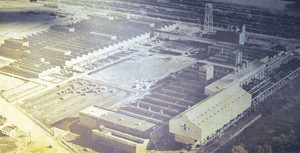“What’s going on with all those trucks?” is a question that I often hear in connection with the row upon row of semis filling the lots at the old International Harvester (Navistar) facility along Brookville Road at Ritter Avenue. Once the production site for International truck engines, today only about ten percent of the vast industrial complex is being used to rehab engines in pre-owned International vehicles for the re-sale market.
For seventy years the comforting blast of the 7:00 a.m. plant whistle pierced the air of the surrounding Irvington neighborhood announcing the beginning of another day of production — the pouring of iron for engine blocks and their machining into sturdy International engines — and the employment of hundreds of workers in good paying jobs. On July 31, 2009 the whistle stilled for the machine shops. The foundry came under the control of Pure Power Technologies, a division of Navistar, which committed $19,000,000 (2015: $20,511,151.89) to upgrade the facility so that it could pour a revolutionary light weight iron, one of only a handful in the world with this capability. However, after this brief reprieve, six years later the last glowing molten brew was poured in the foundry and the cupola went cold.
Indianapolis welcomed the announcement in June 1937 that International Harvester would “immediately begin construction of a $4,000,000 (2015: $66,739,689.80) motor factory on a 75-acre tract of ground southeast of the city.” The new plant would produce engines for International trucks and employ 3,000 workers. Fidelity Farm, owned by Warren Township pioneer Corydon R. Shimer and lying south of Irvington adjacent to the Pennsylvania Railroad’s Hawthorne Yards, was selected as the site of the new plant. A Marion County showplace, Fidelity Farm was known for its prize Jersey cattle and boasted a race track (where the foundry now stands) used to exercise horses. For a small fee on Sundays the public could ride their bicycles around the track. In the summers of 1935 and 1936, a driving range built on the west side of the farm was a popular with golfers.
Following ground breaking on August 16, 1937, construction of the new industrial facility proceeded quickly and on February 23, 1938 the first production part, a drive pulley, was turned out; the first engine came off the assembly line on April 4. The foundry was completed in 1939 with the first pour of molten iron on July 23. From an initial production of 680 gasoline truck engines per day and the pouring of 300 tons of gray iron castings per day, by the mid-50s one truck engine could be produced every 35 seconds in an eight-hour shift and the foundry was pouring 550 tons of iron daily. With expansions of the physical plant, the International Harvester Indianapolis Truck & Engine Works now had a total of 945,000 square feet (22 acres) under roof.
Factory production shifted from civilian to military use a short time after International Harvester opened its Indianapolis engine works. During World War II, the plant made engines to power military vehicles for the United States Army, Navy, and Marine Corps. Gun mounts for the Navy’s Oerlikon anti-aircraft gun and track shoes for the Army’s half-track personnel carrier were also part of the plant’s wartime work. Three Army-Navy “E” awards for “excellence in production” were bestowed on the employees (75 percent of whom were women) of the Indianapolis facility.
The production of engines for civilian use resumed after the war. In 1965 the first diesel engine was manufactured, and nineteen years later the last gasoline engine came off the line. The following year, International Harvester sold its agricultural division, and with only its truck and engine division remaining, the company changed its name to Navistar International in 1986. By the time the Indianapolis Truck & Engine Works closed in 2009, nearly 10,000,000 engines (4,959,172 gasoline engines; 4,311,935 diesel engines; and 595,376 service engines) had been produced at the factory — powering trucks, buses, farm tractors, combines, stationary engines, generators, air compressors, runway sweepers, pick-up trucks, Scout SUVs.
Besides providing employment for thousands of Eastsiders and contributing millions to the Warren Township tax base, the Brookville Road plant was a “good corporate citizen and neighbor.” Area high schools benefited from vocational training programs and the company was a sponsor of the Irvington Halloween Festival for years. There was also support for employee inner-plant bowling leagues, the four-wheel drive clubs, and the teams playing on the old baseball diamond. Today, a visible reminder of this neighborliness is the bust of Washington Irving that stands in Irving Circle Park which was cast in the foundry.
Although this east side industrial institution is now idle, the Irvington Historical Society has a permanent exhibit at the Bona Thompson Memorial Center, 5350 E. University Ave., which tells the story of the International Harvester Indianapolis Truck & Engine Works. The large exhibit of memorabilia includes the famous Blue Diamond cut-away gasoline engine that was on display in the Industrial Exposition at Union Station. With a press of a button, an electric motor slowly turns the crankshaft and moving parts — pistons, valves, fan, etc. — go into action. You can see a glimpse of the industrial might that made America great any Wednesday, 1-3 p.m. and Saturdays/Sundays, 1-4 p.m.



